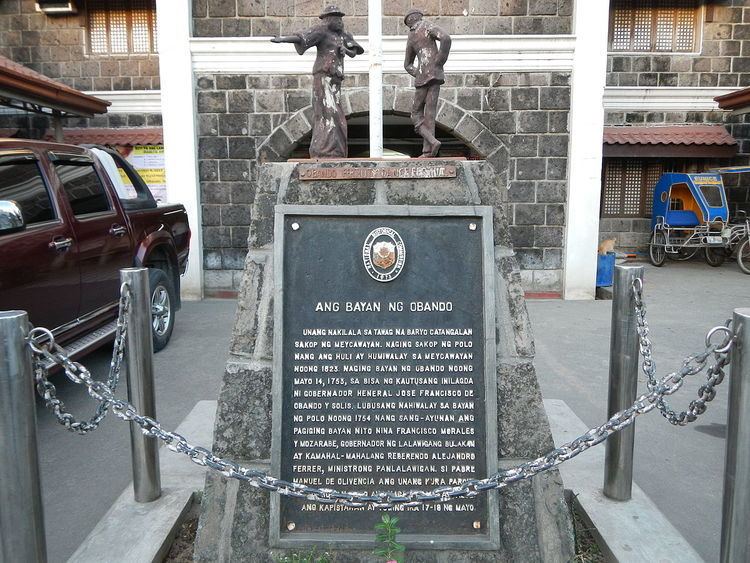 | ||
The Obando Fertility Rites are a dance ritual and Catholic festival celebrated every May in Obando, Bulacan, Philippines. Locals and pilgrims, sometimes dressed in traditional costume, dance and sing in the town's streets to honour and beseech Obando's three patron saints: San Pascual (Paschal Baylon), Santa Clara (Clare of Assisi) and Nuestra Señora de Salambáo (Our Lady of Salambao).
Contents
Festivities
The Rites are observed in a triduum: 17 May for St. Paschal Baylon, 18 May for St. Clare, and 19 May for Our Lady of Salambáo. Each of the three days usually begins with a morning Mass said by the parish priest. A procession, held immediately thereafter, consists of the three saints' images followed by bands playing instruments made of bamboo or brass, and devotees who dance the fandango while singing the hymn, Santa Clara Pinung-Pino (Saint Clare, Most Refined). The image of each saint leads the procession on his or her designated feast day.
The Rites, especially the fertility dance, are popular with pilgrims from all over the Philippines, most of whom supplicate the triad of saints for a child, a spouse, or general good fortune. Throughout the three days, devotees joyously dance in the streets as a form of prayer, asking for the spirit of life to enter into the wombs of women.
The Philippine national hero, José Rizal, mentioned the Rites in Chapter 6 ("Captain Tiago") of his 1887 Spanish novel, Noli Me Tángere.
Saint Clare
St. Clare of Assisi is the oldest saint declared patroness of Catanghalan (the town's former name), her image first enshrined the chapel built by missionaries of the Order of Friars Minor in the town. St. Clare was a 13th-century Italian nun, who founded the Poor Clares according to the rule and teachings of her contemporary, St. Francis.
St. Clare became the patroness of good weather because her Spanish name, Clara, also referred to clearer skies after a storm. This formed the basis for the Filipino custom of offering chicken eggs to St. Clare to ensure good weather, as the Spanish word for egg white or albumen, claro, is also a pun on her name. Devotees participating in the Rites would sometimes hold eggs as they sway to the fandango.
The introduction of St. Clare by Spanish Franciscans as a replacement for pre-colonial Filipino gods transformed the old, animist Kasilonawan dancing ritual into the offering of the fandango to the saint to prevent or cure sterility in women. Eventually, St. Clare evolved into the patroness of individuals seeking a mate and to have children, particularly daughters.
Santa Clarang Pinong-pino
Saint Paschal
During the 18th century, the Franciscan missionaries built the town church and introduced the veneration of Saint Paschal Baylon. His surname, Baylon, was taken to mean "one who likes dancing", ultimately derived from the Spanish bailar, the verb form of "dance". Like St. Clare, he also became the patron saint of fertility, wealth and abundance.
An anecdote tells of how a childless couple from the neighbouring town of Hagonoy met a youth selling crabs. The young man told the couple to visit Obando and participate in the Rites to ameliorate their condition. Upon entering Obando Church, the couple were amazed by the sight of Saint Paschal's image, for its face looked exactly like the young crab vendor. This is the origin of St. Paschal's patronage of childless couples who wish to have children, particularly sons.
Our Lady of Salambáo
On 19 June 1763, the image of Our Lady of Salambáo (formal title: "Our Lady of Immaculate Conception of Salambáo"), was the last saint whose cultus was introduced to Obando. Legend tells of three fishermen named Juan, Julián, and Diego dela Cruz caught the Virgin Mary's image in their salambáw, a fishing net supported with bamboo crosspieces and mounted on a raft.
They were fishing at a place known as Hulingduong, Binwangan (now part of Malabon), and when they decided to bring the image to the neighbouring town of Navotas, their boat suddenly grew heavy and immobile. When they eventually decided to bring the image to Obando, their boat quickly lightened and became easy to paddle. This was taken a sign that the Virgin wanted to be enshrined in Obando Church. She is still venerated there as the local patroness of fishing and of good harvests.
Ban and post-War revival
During the Second World War, the church and a large portion of Obando were ravaged by fire; included amongst the damaged property were the images of the three patron saints. A few years after the war's end, both the Archbishop of Manila and the vicar of Obando Church forbade the fertility dance due to its pagan origins. During the prohibition, normal religious processions were still held on the triduum, but without the lively street dancing.
In 1972, parish priest Rev. Fr. Rome R. Fernández and the Komisyon ng Kalinangan (Commission on Culture) of Obando helped in having the ban lifted and in reviving the ancient dance ritual, which is still practised to this day.
In popular culture
The Rites were featured in the pilot episode of the Filipino teleserye Ina Kapatid Anak, which used fertility issues as a plot device.
